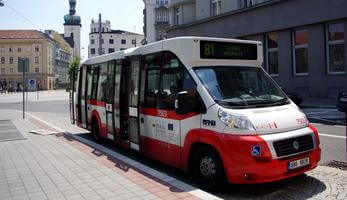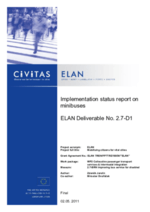Demand - responsive bus service
Summary
Brno was aiming to make its tram and trolley bus network more energy efficient by reducing electricity consumption for the heating system without negative impacts for passengers.
Implementing sustainable mobility
Brno completed its public transport system with five new low-floor minibuses that are accessible to people in wheelchairs and that can provide cost effective and energy efficient regular public transport service during the off-peak hours.
The main objectives of the measure were to:
- Improve the quality of the public service for the people with disabilities and other passengers
- Increase efficiency of the public transport service in the city centre and during the off-peak hours
- Improve the attractiveness and the image of the public transport service
The minibuses operated on certain routes in the city centre with a focus on the needs of the people with disabilities. The two of the bus lines which are connecting the housing areas with hospitals, important institutions and shopping areas meet at an interchange point in the city centre. At weekends, the buses are available for trips outside of the city for groups of people with disabilities. During off-peak hours, in the evening they also operate on lines with low demand.
The smaller buses not only have lower fuel consumption but also better manoeuvrability than the regular buses in the narrow streets of the city centre. They have the capacity to transport at least six wheelchairs at the time with the folding seats that can easily be change to standard seats. the buses also feature ramp and modern information system.
Progress
Nowadays most frequently the minibuses are operating on special lines n.81 and n.82 which are connecting the housing areas and the city centre. These lines have an interchange point in the city centre. During the off-peak hours (in the evenings, weekends) the minibuses are also operating on the lines with low demand where the usage of the standard buses wouldn’t be effective. At the weekends, the minibuses also can be used for trips of the disabled out of Brno (e.g. for shopping).
The service of the public transport is free of charge for people with disabilities.
The measure continues after the end of the project.
Outcomes
Final results:
The impact evaluation shows that the measure was overall a successful example and may be recommended to replicate in other cities. Here we propose the overview of key results:
- Lower emissions (CO, NOX, particles, HC) – the emissions decreased because the emission standard of the buses is higher (old buses - EURO 0 vs. minibuses - EURO 4). Low-floor buses (BAU) have the same emission standard as the minibuses. The targeted decrease by 30% was exceeded.
- Improved vehicle Fuel efficiency – minibuses with lower fuel consumption (19l/100 km) are more than 2.5 times more fuel efficient than the standard low-floor buses (fuel consumption 45 l/100 km) and 1.9 times more efficient than the old buses (fuel consumption 36 l/100). The initial goal to save 10l/100km was therefore exceeded.
- Decreased operating costs - represented by cost on fuel. The operation of the minibuses (0.20 €/km) is 1.7 times cheaper than the operation of the old buses (0.33 €/km). The alternative solution – the operation of the standard low-floor bus (0.53 €/km) would be 2.6 times more expensive regarding the fuel costs in comparison to the minibuses. The target of saving 0.5 €/km was not defined realistically, as the original costs were only 0.33 €/km.
- High acceptance – According to the organised meeting with the target group (disabled citizens) appreciates the direct connections with the city centre and the hospitals provided by minibuses, especially during the winter when it is difficult to use other connections such as the low-floor trams, trolleybuses or buses.
- Number of use – the planned target to raise the number of transported disabled people by 10% was not met. On the contrary, the number of the users of the minibuses is decreasing from 2009. But it can be explained as a result of the increasing number of low-floor vehicles in the public transport fleet. Therefore the disabled passengers have now more possibilities to travel and they are using other PT vehicles than minibuses.
- Increased number of connections - the targeted increase in the number of connections by 50% was not met, although there was an important increase in the number of connections between 2009 and 2011 on both lines, due to the better manoeuvrability of the minibuses new stops can be created,. On the line n.81, there are 20 more connections. The number of connections increased by 14 on the line n.82.
- Positive CBA -The one-to-one comparison of the Business As Usual analysis (BAU) (standard low - floor buses) with the measure (the minibuses) found a positive Net Present Value (NPV) of 318 585 € over 10 years.
Although the initial investments for the new minibuses were high, their operational savings have been very significant so the initial investment should be repaid within the minibuses lifetime. Only the fuel efficiency is 2.5 times better when DPMB use the minibus instead of standard low-floor bus.









